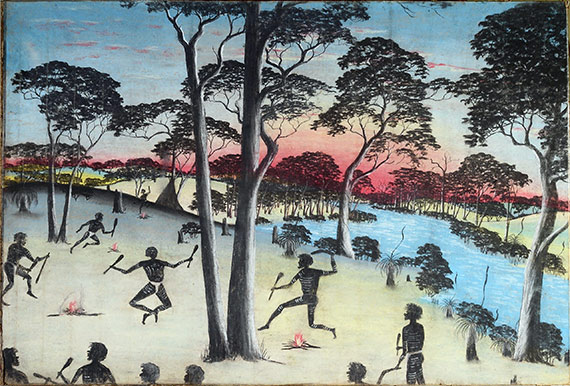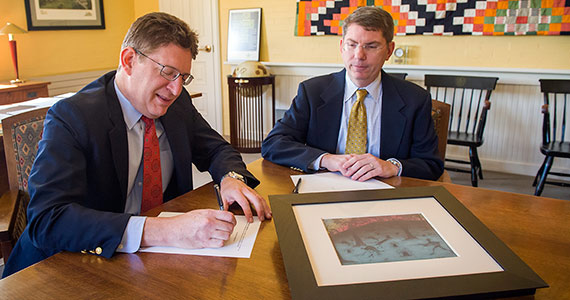
This 1949 painting by Reynold Hart is called βA Native Corroboree.β It is one of the 119 indigenous artworks going from ΜΗΠΔ΄«Γ½ to Curtin University in Western Australia.
In an important example of international, cultural, and educational collaboration, ΜΗΠΔ΄«Γ½ will give 119 indigenous artworks to in Western Australia. The works, a significant part of the heritage and history of the region, were created by Noongar children who were part of Australiaβs βStolen Generations.β
The artwork, which includes drawings and paintings produced between 1945 and 1951 at the Carrolup Native School and Settlement in the southwest region of Western Australia, was the subject of international news coverage in 2005 when it was exhibited in ΜΗΠΔ΄«Γ½βs Picker Art Gallery.
In recognition of the gift, Curtin University Vice Chancellor Professor Jeanette Hacket and ΜΗΠΔ΄«Γ½ Provost and Dean of the Faculty Douglas Hicks signed a memorandum of agreement today during a ceremony at the Centre for Aboriginal Studies at Curtin University. A painting, βHuntingβ by Reynold Hart, was given at the ceremony to symbolize the future transfer of the full collection.
Hacket said the longstanding academic connection between Curtin and ΜΗΠΔ΄«Γ½ has created a strong relationship that is expected to continue for many more years. βWe are grateful that ΜΗΠΔ΄«Γ½ sees the deep and enduring value in returning the art to Noongar country,β she said.
The Noongar art pieces were given to ΜΗΠΔ΄«Γ½ in 1966 by Herbert Mayer β29, a well-known New York City collector. He had purchased the works from a major benefactor to the Carrolup School, Florence Rutter, who provided funds to the school and its children.
The artwork features native landscape and bush scenes as well as animals, hunting, and traditional Noongar cultural activities. The genre has influenced the work of several well-known contemporary Australian artists.
MORE:
- New York Times article:
The Carrolup collection represents a painful time in Western Australian history. Between 1910 and 1970, an estimated 100,000 Aboriginal children were forcibly removed from their parents and sent to institutions or placed with white foster families.
This policy was designed to βassimilateβ indigenous people, and these children became known as the βStolen Generations.β Former Prime Minister Kevin Rudd apologized to the affected families on behalf of the Australian government in February 2008.
The collection has been, and will continue to be, the focus of joint study between Curtin and ΜΗΠΔ΄«Γ½. During the past eight years, many ΜΗΠΔ΄«Γ½ students, under the guidance of Professor Ellen Percy Kraly, William R. Kenan Jr. Professor of geography, have travelled to Western Australia to visit the Mungart Boodja Art Centre and the John Curtin Gallery at Curtin University to learn about Noongar art and culture in the region.
Kraly initiated the talks among ΜΗΠΔ΄«Γ½, Curtin, and Noongar leaders. βThe relocation of the art will allow both the conservation and exhibition of the work for future generations of Noongar people and others in Western Australia,β she said. βThe work has so much meaning in country that it deserves to be within the hearts, souls, and eyes of the people.β
Hicks said that ΜΗΠΔ΄«Γ½βs goal is to provide access to the art for Noongar people, particularly those in rural Western Australia. βWe hold these treasures in high regard and expect to continue and even extend the cooperative educational and exhibition efforts around them,β he said.
The gift of the artwork is the result of more than a year of discussion between ΜΗΠΔ΄«Γ½ and Curtin, and consultation with the representatives from the Mungart Boodja organization.
Spokesperson for the Mungart Boodja organization Ezzard Flowers said the community was pleased to see the historic art returned to its country of origin.
βIt is a time for celebration in Noongar country and in Western Australia. We are very grateful to our friends at ΜΗΠΔ΄«Γ½ who understand how much this means to us.β
